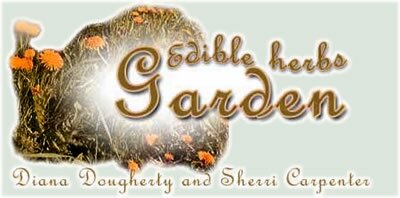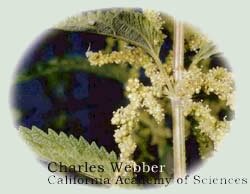|

Nettle
Urtica species
Other Names
Stinging Nettle
Urtica dioica
Wood Nettle
Laportea canadensis
Slender Nettle
Urtica gracilis
Uses
Parts used: leaves, stems. Tender young plants raw in salds, cooked in soups or dried and used medicinally in tea or tinctures
Uses: Stems and leaves boiled in several changes of water will render the leaves edible as a spinach substitute. The leaves and stems can be steeped raw in a bucket of water for 24 hours. The water is than used as an organic pesticide for mites and aphids. Use freeze-dried for hay fever (a study showed it rated better than just dried). An expectorant used for asthma, mucus conditions of the lungs, and chronic coughs. A tincture is used for flues, colds, bronchitis and pneumonia.
As an infusion, it is a safe diuretic used for the kidneys and bladder as in cystitis and nephritis. A tea compress is good for wounds, cut, stings, and burns. The infusion used internally is said to help the blood clot. Used for bleeding from hemorrhages, bloody coughs, nosebleeds and bloody urine. Is also good for gout, glandular diseases, poor circulation, enlarged spleen, diarrhea, and dysentery, worms, intestinal and colon disorders, hemorrhoids, and urinary inflammation. Has a cooling energy and is drying and astringent.
Healing
Stimulates bile production from the liver. A good over all tonic that helps to cleanse and strengthen the body. It contains all the nutritive salts that are required for the body to purify the blood (good for anemia) A slight appetite stimulant. A hepatic herb, which works well on the liver by toning it, nourishing it and strengthening it. Also good for the bladder, spleen, pancreas, stomach, and intestines.
Nutrition
Nutritional Value: Very high levels of minerals, especially calcium, magnesium, iron, potassium, phosphorus, manganese, silica, iodine, silicon, sodium, and sulfur. Also a good amount of chlorophyll and tannin and a good source for vitamin A, C, beta carotene, and B-complex vitamins. It also has high levels of absorbable amino acids. They're 10 percent protein, more than any other vegetable. Eating or drinking the tea is said to make your hair brighter, thicker, and shinier, and makes your skin clearer and healthier-good for eczema and skin conditions.
Cultivation
Cultivation: Start from seed or take cuttings. Plant about 6 inches apart after the danger of frost. Likes light shade and moist soil.
Comments
Comments: It should be used with caution with anyone taking medications for blood-thinning as it will decrease it effectiveness. Use gloves when harvesting. There are a few things that are said to be effective against its sting, they are, Jewelweed and Yellow dock (crush the leaves), mud, and toothpaste.
Seed or plant sources.
seeds: http://www.raingardens.com/seedpage/medicine.htm
look under dwarf stinging nettle.
Purslane
Portulaca oleoracea
Uses
Part used: leaves, stems, and seeds. Eaten raw or cooked or pickled. Can be stored dry or frozen.
Healing
Contains significant minerals or compounds that has been reported to have antidepressant qualities. It has been used as a purgative, cardiac tonic, muscle relaxant, and in anthelmintic, anti-inflammatory and diuretic treatment. Has been used for headaches, burns, trauma, stomach, and intestinal and liver ailments.
The omea-3 content it helps to regulate metabolism and distribution of serum cholesterol and triglycerides in the circulatory system .
Nutrition
A good source for vitamins A, C and E essential amino acids. Rich in glutathion, a powerful antioxidant and immune builder. High in linolenic acid, an omega-3 fatty acid and rich in calcium, magnesium, phenylalanine, potassium and tryptophan. Contains significant minerals or compounds that are reported to have antidepressant activities.
Cultivation
Plant is susceptible to frost damage. Can be started by seed or stem fragments. Prefers a light well-drained soil, in a sheltered, sun to light shade. Sow outdoors from May-July, for a crop through the summer month. Many garden outlets will have them in the spring. Take cuttings from the new plant and place them into the new soil and water them. In no time they will take root and become plants on their own
Comments
A study was conducted to grow purslane for the most optimal linolenic acid concentration. They recommend growing under low light intensity, day lengths were 14 to 16 hours and 60% of the total nitrogen was supplied in the form of ammonium.
Seed or plant sources.
www.fedcoseed.com
www.seedsofchange.com
Kudzu vine
Pueraria lobata
Uses
Parts used-tuber, leaves, flowers
boiled, steamed, fried, flowers in tea
Healing
The root powered or in a tea is used for inflammation, hangovers, indigestion, respiratory disorders, headaches, sinus troubles, muscle stiffness, kidney troubles, skin rashes and reduces blood pressure. Kudzu starch can be extracted from the root and powdered to use a thickening agent in cooking. The vines can be used to make baskets and paper. Has been used as animal fodder.
Nutrition
Nutritional Value-high in vitamins C and A with a good amount of protein, calcium, potassium, phosphorus and iron.
Cultivation
Llikes moist, humid weather with a long growing season. Propagation use crowns or cuttings. Can be grown in depleted soil. It is in the legume family and is a nitrogen-fixing plant. Can be grown as a cover crop and tilled under to replace nitrogen in the soil.
Comments
Can be seen growing wild all over the southeast. Has been found as far north as WA state. Very invasive and can grow a foot a day. Will cover houses, tractors, trees, and anything else it can grow on. Be careful where you plant it.
Seed or plant sources.
Lamb's Quarters
Chenopodium album
(also known as Pigweed)
Uses
Parts used: leaves, seeds
Healing
A poultice can be made for bug bites, sunstroke, rheumatic joints and swollen feet. It is used as a laxative, and to treat various symptoms attributable to nutritional deficiencies. Said to be sedative and has refrigerant properties. It is also said to kill parasites and worms.
Nutrition
Very high in vitamin A, calcium, potassium, and phosphorus and is a good source of protein, trace minerals, B-complex vitamins, vitamin C, iron, and fiber.The seeds are high in protein, calcium, phosphorus, potassium, and niacin.
Cultivation
Sow seeds in spring space 6 to 12 inches a part. Likes a moderately fertile soil, full sun and moist soil.
Comments
The seeds should be soaked in water overnight and rinsed before use to remove any saponins. It will absorb pesticides from the soil and is prone to accumulate high amounts of nitrates. Contains high amounts of oxalic acid (like spinach) and should be feed in moderation.
Seed or plant sources.
http://www.richters.com/
http://www.organicseed.com/seedindex/ look under salad greens.
|